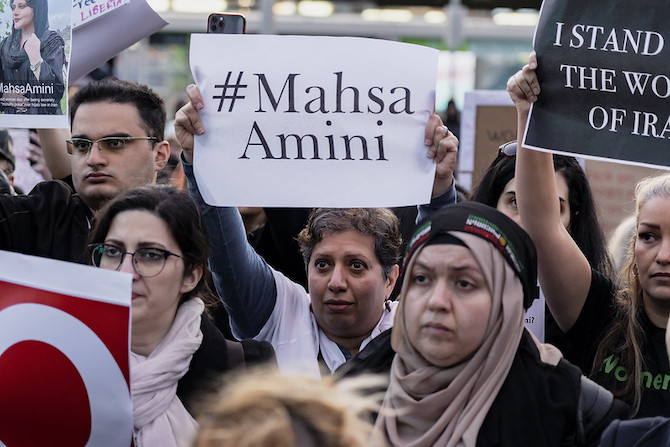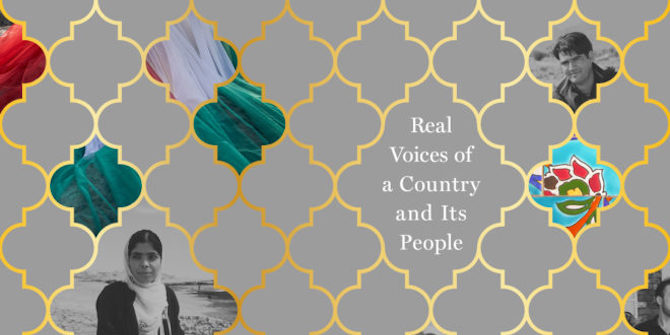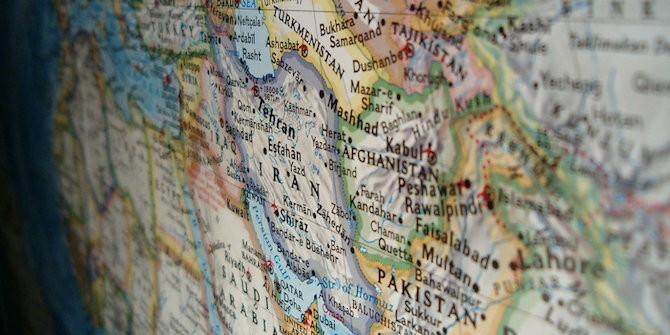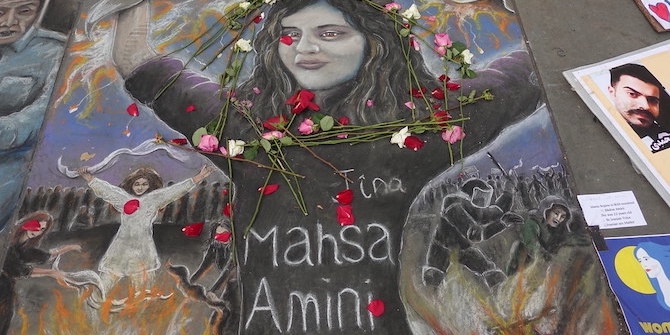by Angeliki Tzampazi

Women in Iran have a long history of participation and engagement in socio-political movements, especially in the aftermath of the Islamic Revolution (Shirazi, 2012). Information Communication Technologies and social networking platforms have helped women to connect and communicate within digital networks, while the same digital tools bridge the cultural and socio-economic gap women face in gender and discriminatory laws (Kermani and Hooman, 2022; Shirazi, 2012).
The hashtag feminism movement has been quite successful in mobilising Iranian women both domestically and internationally. In 2020, the hashtag #rape was a space for Iranian users to communicate abusive experiences, discuss sexual assaults and speak on harassment. The main goal of users was to advocate against the rape culture and support victims by promoting cyberactivism (Kermani and Hooman, 2022). Digital feminism is seen as a digital community of connection, solidarity and empowerment for women, who fight for women and human rights that are the core of social development.
The most recent digital feminism movement fuelled by hashtag feminism was that of #MahsaAmini, which took over Twitter in autumn 2022. The hashtag was launched to protest the brutality of Iran’s morality police, who killed a 22-year-old Kurdish woman in custody, on 16 September 2022, sparking huge protests. In this case, traditional activism (e.g. street demonstrations) and cyberactivism (e.g. Twitter) were mutually aiming to challenge the ethnocentric, militant and theocratic-authoritarian regime and enable a democratic discourse on an important cultural and social issue, that of the hijab (Kermani, 2023). At this point, it is crucial to highlight that the uprising in Iran “Women, Life, Freedom” has deep roots in the Kurdish people of Iran, who have always been pioneers of the struggle against oppression. In addition, the slogan of the movement comes from a socialist-feminist slogan: Jin, Jian, Azadi.
Taking into consideration other issues facing Iran including the economic crisis, poverty, unemployment and the oil price; intersecting with deep cultural, political and socio-economic matters, have hurled the country into turmoil. Protests in Iran were so widespread and contagious because human rights including women rights and social justice are directly linked with social and political rights (Kermani, 2023).
One year later, coming to the first anniversary of Mahsa Jina Amini and the Iranian women’s protest movement, it seems that the current situation in Iran is still unstable and fragile. The impact of Iranian women’s protests on disrupting the regime is ongoing. Simultaneously, Western leaders marked the anniversary with statements and awards. The European Parliament awarded the 2023 Sakharov Prize to Mahsa Jina Amini and the Iranian women’s protest movement. President Metsola declared: ‘On 16 September we marked one year since the murder of Jina Mahsa Amini in Iran. The European Parliament proudly stands with the brave and defiant who continue to fight for equality, dignity and freedom in Iran’. The White House released a statement from President Joe Biden: ‘Today—as we remember Mahsa’s tragic death—we reaffirm our commitment to the courageous people of Iran who are carrying on her mission. They are inspiring the world with their resilience and resolve. And together with our allies and partners, we stand with them’.
While there is acknowledgement across democratic nations of Iran’s arsenal of oppression, at the end of September 2023 Iran’s parliament passed the ‘Hijab and Chastity Bill’, which amongst others imposes severe punishments on women and girls for non-compliance. Instantly, UN experts expressed their serious concerns over Iran’s bill in compliance with international human rights law.
It did not take long for the concerns to be validated, as another incident came to the surface. According to the Financial Times and other sources, a 16-year-old girl, Armita Geravand, was declared dead 28 days after being admitted to intensive care. As reported by the Iranian government, Armita collapsed on a train inside Tehran’s metro on October 1 on her way to school. While CCTV footage showed her entering a metro train wearing no headscarf and being pulled seconds later unconscious by her friends, activists offered different accounts of what exactly happened. Analysis by Amnesty International’s Evidence Lab detected a gap of three minutes and 16 seconds in the CCTV footage, indicating a cover-up deviating from the truth.
The international community must demand that the Iranian government allow independent organs to enter the country to investigate and pursue legal avenues under international human rights law. Simultaneously, concerns of Iran using technology for suppression and surveillance are being confirmed and examined. Research should follow intersection approaches to explain how digital tools and ICTs impact social, cultural, political and economic transformations. Of course, it is vital to understand every unique political, cultural and socio-economic environment in which cyberactivism and digital feminism are practised; to argue whether ICTs are better or worse for development. Iranian women paved the way and manifested social development through ICTs.
MENA Solidarity Network has recommended ways the public can support:
- Participate in protests against repression called by Iranian activists outside Iran
- Act decisively to prevent executions of protesters in Iran by writing to your country’s Iranian Embassy calling for the release of those arrested and subjected to unfair trials
- Join digital solidarity networks and stand with Iranians fighting for human rights
This piece was first published by the International Development LSE blog under the title: ‘Cyberactivism and Digital Feminism – The Social Unrest of Iranian Women: Mahsa Jina Amini and Armita Geravand‘.
[To read more on this and everything Middle East, the LSE Middle East Centre Library is now open for browsing and borrowing for LSE students and staff. For more information, please visit the MEC Library page.]






